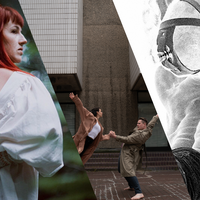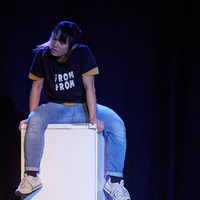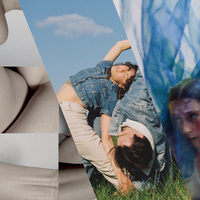Fri 2 Feb: Ella Swannell Amalfitano, Elly Trent, Olia Poliakova and Callum Murray, Terry Smith

News Story
Ella Swannell Amalfitano Hold of Us
Elly Trent, Olia Poliakova and Callum MurrayDo it again
Terry Smith The Chair
In “The Empty Space", Peter Brook describes the “Deadly Theatre”, as performances which disguise as proper and classical, yet are secretly excruciatingly boring; and the “Deadly Spectator”, who secretly finds joy in the routine of the boring. Herein, it’s important to remember that Resolution is a place for new choreography and that naturally, pieces may feel unresolved.
I address tonight’s triple bill as a whole, each attempting methods of drama through their choreography: mostly non-verbal sets of movement trying to be narratives of repetition in the process of creation (Do It Again), intertwined characterisations of longing (Hold of Us), and the empty space grief holds (The Chair).
Each piece starts with a presentation of “a setting”: three people lying on the ground / a lobby-like blocking of characters / a chair in a spotlight. Each takes too long to establish the purpose of the world they create; like an extended First Act of a story, which doesn't incite any incidents. Protasis without rising action.
We sit in silence, bearing witness to whatever is placed on the stage in front of us. Is everyone in the audience just like me? Trying to find meaning in every piece. And whatever meaning I gleaned in Do It Again, I remember that the process, a repetition of “again and again”, boring as it may seem, is more important than the result. We have to disentangle ourselves from the deadly expectations of a show, like how each character felt entwined but separate in Hold of Us; or in The Chair, when the artist leaves the stage, what remains is an empty chair, an empty space.
Resolution is a place for new choreography. In our struggle to make anew, we need to challenge, develop, experiment, create and present. Raw as is, unresolved as it is, we have not yet seen these artists’ Second Act.
Brian Toh
"The festival is about experiment" is the line that jumps out at you from Place Artistic Director Eddie Nixon's introductory notes to all the Resolution shows, and bold, unforgiving, experiment seemed the watchword of Friday night's particularly dramatic pieces.
Do it Again is a work for three about creating a work, split into two: the creation in a bare, well-lit studio, followed by a very brief performance under moody dark lighting with much smoky haze. "Do it Again explores the playful, challenging and tedious act of practice" start the programme notes. And I certainly picked up on the tedious, big time, as one directing performer twiddled electronic sound knobs and wrote post-it notes at a table while the other two repetitiously repetitiously (that was not a typo) played out not-so-memorable or challenging movement interactions and slowly removed many, many layers of clothing, beneath a wayward digital timer. It felt like a surreal work trapped somewhere between humour and reality, and to develop needs to build on one or the other.
Following the surreal, the remainder of the night took on the darker side of the human condition, first with Ella Swannell Amalfitano's Hold of Us. It's an episodic piece for 6, exploring dissociation and feelings of longing and despair in various contemporary solos and duets. It felt at its best as one human being sought to support others, but for the most part, I saw generic dramatic, despairing movement, but not the deeper character within that would drive home such unhappiness - it didn't get under my skin. Hold of Us might deliver more with fewer character dancers coloured in more depth.
The unhappiness theme piled on as despair turned to suicide, the subject of Terry Smith's The Chair. Thoughtfully danced in silence by Lise Boucon, it uses a chair as a cipher for the departed's spirit and has Boucon grappling around and with it in contorted positions as she tries to work through her feelings about such a calamitous event. At first I was much moved, but the work didn't seem to develop and as the chair slowly receded from front of stage to back, into the ending curtain-down blackness, we all felt a sense of relief and that our night could only brighten up.
Bruce Marriott


